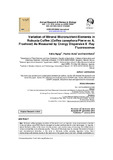| dc.description.abstract | Aim: Robusta coffee growing countries of the world such as Uganda, have experienced a decline
in market prices since 2002 due to changed consumer preferences for other beverages. In Uganda,
where Robusta coffee is the major income earner, one practical way of ensuring that coffee prices
remain competitive is to enhance quality. The aim of this study was to analyze the extent of macro
and microelement densities in the soils of Robusta coffee growing Ugandan farms, their
relationships with density levels in the leaf and in the green bean and their ultimate contribution in
the determination of cupping and marketing qualities. This information would enable coffee
producers in Uganda to make decisions on which organic and inorganic fertilizer applications are
needed to alleviate coffee quality which in turn is the key determinant of world prices.
Study Design: Soil, leaf and ripe cherry samples were derived from sixty seven tagged trees in
twenty three on farm locations at Kawanda and Entebbe in fields that had no fertilizer application
history.
Place and Duration of the Study: This work was conducted at the National Agricultural Coffee
Research Institute (NaCORRI), Uganda and the Institute of Nuclear Science and Technology,
University of Nairobi, Kenya, between January 2010 and December 2013.
Methodology: Nutrient densities of potassium (K), calcium (Ca), iron (Fe), titanium (Ti), zinc (Zn),
copper (Cu), boron (B), lead (Pb) and manganese (Mn) of sixty seven soil, leaf and green bean
samples collected from 23 districts were measured with Energy dispersive x-ray fluorescence
(EDXRF). All the samples were oven-dried at 800C for 18-20 hours and ground to about 50 mm
sieve-size. Three pellets of 2.5 cm in diameter were made and irradiated with a Cd-109 radioactive
source. The X-rays emitted by the elements were detected by liquid nitrogen cooled Si (Li) detector
and data analyzed with the Quantitative X-ray Analysis System (XQAS/AXIL) software.
Results: The results showed that the mean concentrations of Ca, Mn, Fe and Zn were highest in
the soil but lowest in green beans. K concentrations were higher in green beans than in the leaf
and were lowest in the soil. In most cases, the concentrations of microelements found in the soil
determined the levels in the leaf and in the green bean. Microelement availability and
concentrations were influenced by the interaction between the various elements, tree age,
elevation, soil texture and location.
Conclusions: Mineral element K and microelement Cu were found in their highest concentration in
the green bean. Mn, Zn and B were important elements in the determination of organoleptic cup
attributes whereas soil, leaf and green bean nutrient concentrations were important in determining
the medium size of the bean. | en_US |



